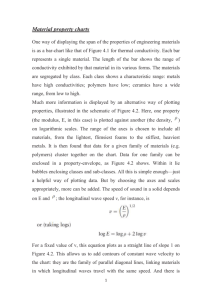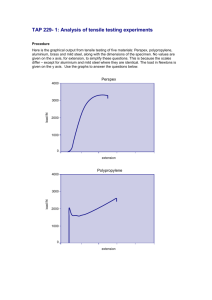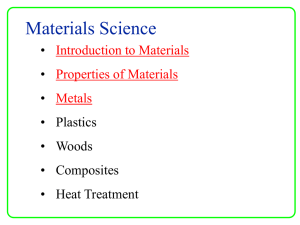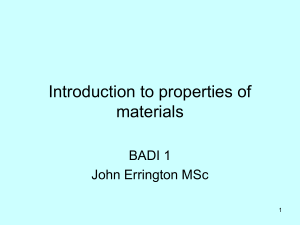Episode 229: Stress-strain graphs
advertisement
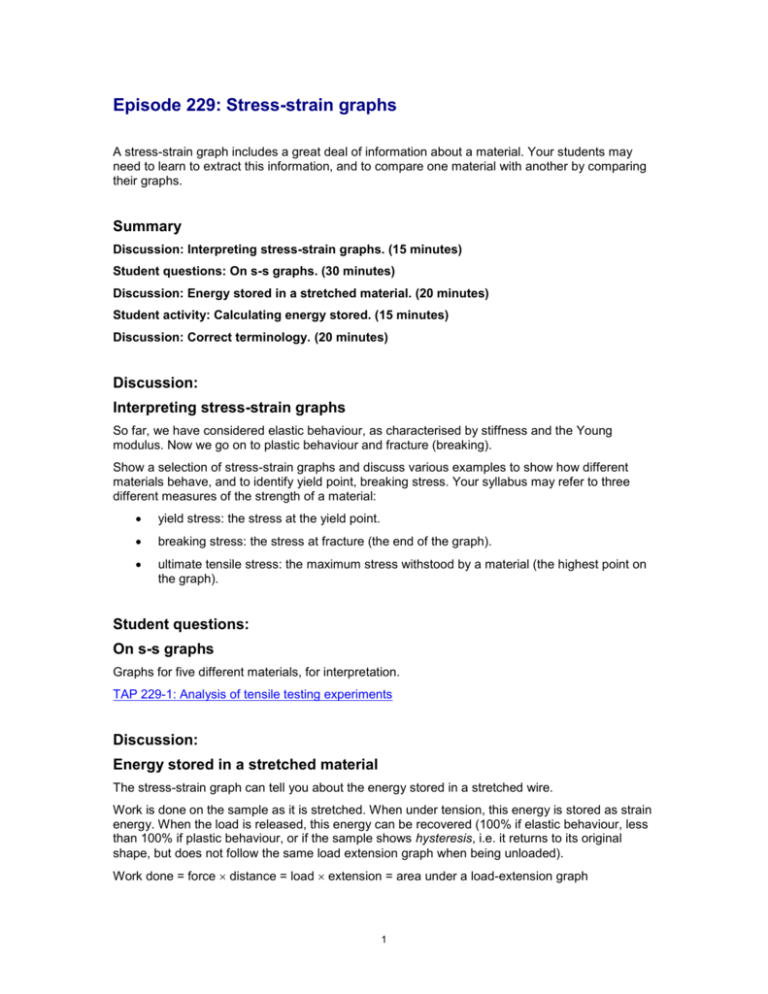
Episode 229: Stress-strain graphs A stress-strain graph includes a great deal of information about a material. Your students may need to learn to extract this information, and to compare one material with another by comparing their graphs. Summary Discussion: Interpreting stress-strain graphs. (15 minutes) Student questions: On s-s graphs. (30 minutes) Discussion: Energy stored in a stretched material. (20 minutes) Student activity: Calculating energy stored. (15 minutes) Discussion: Correct terminology. (20 minutes) Discussion: Interpreting stress-strain graphs So far, we have considered elastic behaviour, as characterised by stiffness and the Young modulus. Now we go on to plastic behaviour and fracture (breaking). Show a selection of stress-strain graphs and discuss various examples to show how different materials behave, and to identify yield point, breaking stress. Your syllabus may refer to three different measures of the strength of a material: yield stress: the stress at the yield point. breaking stress: the stress at fracture (the end of the graph). ultimate tensile stress: the maximum stress withstood by a material (the highest point on the graph). Student questions: On s-s graphs Graphs for five different materials, for interpretation. TAP 229-1: Analysis of tensile testing experiments Discussion: Energy stored in a stretched material The stress-strain graph can tell you about the energy stored in a stretched wire. Work is done on the sample as it is stretched. When under tension, this energy is stored as strain energy. When the load is released, this energy can be recovered (100% if elastic behaviour, less than 100% if plastic behaviour, or if the sample shows hysteresis, i.e. it returns to its original shape, but does not follow the same load extension graph when being unloaded). Work done = force distance = load extension = area under a load-extension graph 1 This result is valid for any shape of force extension graph. For Hookean materials the area required is a triangle. Area of a triangle = 1/2 base height = 1/2 load extension = 1/2 F x = 1/2 k x2 For a material, energy stored per unit volume = 1/2 stress strain Force Total energy input Heat Energy produced in the rubber band Useful recoverable energy Extension (resourcefulphysics.org) Student activity: Calculating energy stored Students can calculate values for the materials used in their measurements of the Young modulus. Discussion: Correct terminology Since much of the terminology used in this topic can cause confusion, it is worth ensuring that students have grasped the different concepts. You could ask them to define the following terms in their own words: stiff, strong, weak, elastic and plastic. Extend this to include the following: brittle (cracks or breaks without plastic deformation); ductile (can be deformed under tension); malleable (‘hammerable’ - can be deformed under compression). Finish by looking at some charts which summarise how various properties of materials are related to one another, and which are used by engineers in selecting materials for particular applications. TAP 229-2: Introduction to materials selection charts 2 TAP 229- 1: Analysis of tensile testing experiments Procedure Here is the graphical output from tensile testing of five materials: Perspex, polypropylene, aluminium, brass and mild steel, along with the dimensions of the specimen. No values are given on the x axis, for extension, to simplify these questions. This is because the scales differ – except for aluminium and mild steel where they are identical. The load in Newtons is given on the y axis. Use the graphs to answer the questions below. Perspex 4000 3000 2000 1000 0 extension Polypropylene 4000 3000 2000 1000 0 extension 3 Aluminium 2000 1500 1000 500 0 extension Brass 8000 6000 4000 2000 0 extension 4 Mild steel 5000 4000 2000 1000 0 Questions 1. Find the yield load for each specimen. 2. Find the maximum load for each specimen. 3. Which has the larger Young modulus – aluminium or mild steel? Hints 1. The yield point is the point where the graph stops being linear – i.e. it passes from the elastic region, where load is proportional to extension, into the non-linear plastic region where additional load produces increasingly larger extensions. Mark this and measure off the corresponding load. 2. This is, literally, the maximum value of the load. Note that the graph dips down after this before fracture actually occurs (at the end point of the graph). This occurs because of the local narrowing, known as necking, of the specimen on application of the maximum load. Since stress is load divided by area, if the area is decreased, then so is the load required to produce the same stress, which is already sufficient to break the specimen. 3. Think about the steepness of the gradient. 5 Practical advice The chart speeds differ for each specimen, and this gives different scales on the x axis. The graphs are not sensitive enough to allow accurate determination of the Young modulus, so a comparison between aluminium and mild steel is asked for instead. Answers and worked solutions 1. Perspex 1260 N, polypropylene 970 N, aluminium 300 N, brass 1080 N, mild steel 2300 N. 2. Perspex 3070 N, polypropylene 1230 N, aluminium 1470 N, brass 4100 N, mild steel 3440 N. 3. Steel – the gradient of the straight part of the line is steeper and the Young modulus is the slope. External references This activity is taken from Advancing Physics Chapter 4, 40S 6 TAP 229- 2: Introduction to materials selection charts Mechanical properties – in physics, and design Materials selection charts are a novel graphical way of presenting material property data. Most mechanical characteristics extend over several orders of magnitude, so logarithmic scales are used. Individual properties could be plotted as bar charts, but a 2D plot of a pair of properties is much better, as we will see. Here is an example – Young modulus against density – showing where the data for the different classes of materials fall. Used with the kind permission of Professor M.F. Ashby. For more information and teaching resources click here. Notice that the bubbles for a type of metal or polymer (steels, or aluminium alloys, or nylon) are mostly small. The density and Young modulus of steel only depends on the way the iron atoms are packed, and the bonding between them – alloying or heat treatment have almost no effect. We call these 'microstructure-insensitive' properties. The spread of the data on a selection chart therefore enhances our appreciation of the underlying physics of each property. As the name suggests, materials selection charts are also a valuable tool in engineering design. Designers have a challenging task in choosing materials for products, as they usually have to consider many competing objectives and constraints at once – light and stiff, strong and cheap, tough and recyclable (or maybe all of these at once!). Materials selection in design is therefore a matter of assessing trade-offs between several competing requirements. Traditionally designers have used extensive handbooks and their own experience to guide the choice of material in design. Selection charts provide insight into these trade-offs by pairing properties which must commonly 7 both be considered, avoiding the need to work with tedious tables of numerical data. As an example – what materials might be used for a light, stiff bike frame? Consider what falls towards the top left corner of the first chart – woods, composites, some metals, and ceramics. Ceramics don't sound very likely, but we have only considered two properties. Physical Insights Stiffness measures how much something stretches elastically when a load is applied. Young modulus measures stiffness and is a material constant, i.e. it is the same whatever the size of the test-piece. Young modulus and density both depend on the atomic packing within the material, and Young modulus depends on the type of bonding between the atoms (electron bond, covalent, ionic etc.) Note how the materials all lie roughly on a diagonal – Young modulus is strongly correlated to density. The metal and polymer bubbles are small – this is because material composition and processing do not have a significant effect on density or Young modulus. Woods have very different stiffnesses depending on whether they are loaded 'with' or 'across' the grain. This is because of the aligned stiff cellulose micro-fibres. Both paper and MDF are made from wood pulp and so have similar densities, but have little directional variation in Young modulus. Foams have the lowest densities because they have pores full of air. Note that the scales are logarithmic, because of the large ranges of values. Applications of the chart Stiff lightweight materials are hard to find, for things like sports products and bicycles – composites appear to offer a good compromise, but they are usually quite expensive, and wood is still used for cheaper products (e.g. oars). Many applications require stiff materials, e.g. roof beams. Many applications require low density materials, e.g. packaging foams. Polymers don't seem like a good choice for stiff, lightweight products – but they can be reinforced by incorporating stiffening ribs into the design (for instance, look inside a plug). Ceramics are quite light and very stiff – but their poor tensile strength and toughness means they are likely to fracture. What about strength and toughness? The next chart illustrates these two important properties. Note that for this chart; 'true' toughness data have been used: Gc, the strain energy release / unit area for unstable crack propagation. This is more universally valid and available than measures such as impact energy. 8 Used with the kind permission of Professor M.F. Ashby. For more information and teaching resources click here. Note that on this diagram the 'bubbles' are much bigger, as the plasticity and fracture of materials are much more sensitive to the material microstructure. In ductile materials they are controlled by plastic flow, which works by motion of defects called 'dislocations'. The motion of dislocations can be impeded by changing the microstructure (by alloying and heat treatment), which makes the material harder, but usually reduces its toughness. In brittle materials like ceramics, strength and toughness depend on the flaws, which this type of material always contains. Returning to the bicycle example, we can eliminate ceramics from the list because of their low toughness. Notice also that the chart shows compressive strength for ceramics (which are high), but they are much weaker in tension. The wider ranges of strength and toughness data can be made even more apparent by populating the material classes on this selection chart too. Look at the strength– toughness chart with a selection of metals illustrated. Note that in general the toughness of a type of alloy falls as its strength is increased, as expected. Physical Insights Strength measures the resistance of a material to failure, given by the applied stress (or load per unit area). The chart shows yield strength in tension for all materials, except for ceramics for which compressive strength is shown (their tensile strength being much lower). Toughness measures the energy required to propagate a crack through a material; it is important for things which suffer impact. The material bubbles are large, particularly for metals – this is because material composition and processing have a significant effect on strength and toughness. 9 The tensile strengths of brittle materials are very sensitive to the presence of flaws. Metals are tough because they deform plastically instead of propagating cracks. Cast iron is often brittle because it contains graphite flakes which behave like little cracks within the metal. Quenching carbon steel makes it very hard but brittle; tempered steel is tougher but less strong than after quenching. Note that the scales are logarithmic, because of the large ranges of values. Applications of the chart There are many cases where strength is no good without toughness. Saw blades, hammer heads and engine components are commonly made of quenched and tempered steel to get moderately high strength with good toughness. Steel is often used to absorb energy in car impacts because it is tough and strong. Ceramics cannot be used for components which suffer impact because of their low toughness. Polymers are quite sensitive to cracks and defects as they do not absorb much energy when they fracture; they are often considered to be tough however because of their ductility – energy is absorbed straining the material to failure. This makes them good for children's toys, when their low strength is also not important. Used with the kind permission of Professor M.F. Ashby. For more information and teaching resources click here. 10 Electrical Properties Designers are not only concerned with mechanical problems like stiffness and strength. Many products have electrical, thermal or optical design requirements too. Materials selection charts can help us with these properties too – and as before, the way the materials fall on a chart gives a simple appreciation of the underlying physics of, for example, electrical conduction. As an example look at the next chart, showing the electrical resistivity, plotted against cost/kg of material. In an engineering context, material cost is almost always important, so selection charts often show this on one axis. Used with the kind permission of Professor M.F. Ashby. For more information and teaching resources click here. This chart shows that metals, which are clearly conductors, have much lower resistivity than almost all other materials. Polymers and ceramics fall at the top of the chart, being insulators. It is worth noticing that the range of resistivity is huge – the diagram covers 24 orders of magnitude, and some insulators fall above the chart. This makes the metals look rather similar in electrical resistivity – but notice that the range across the metals is more than a factor of 1000! Clearly in selecting a conductor these are very significant differences – so the best materials are those which lie towards the bottom of the metals bubble, such as copper and aluminium. Gold is excellent, but it is so expensive it is way off the scale of the chart. Even so, it is used for electrical contacts in microcircuits. Finally, thermal conductivity and electrical conductivity are closely related, as the underlying physics is similar. The electrical resistivity chart also gives an indication of thermal properties – with many thermal insulators towards the top (polymers and foams, and ceramics) and some good thermal conductors – metals – at the bottom. The range for thermal conductivity is also large, so metals in themselves vary quite significantly in thermal properties. 11 Physical Insights Metals are much better conductors than other materials because their atoms are ionised, bonded by a 'sea' of free electrons which also carry current. Pure metals are better conductors than alloys – this is because electrons travelling through the lattice of ions are obstructed by irregularities such as alloying atoms. Polymers and ceramics are good insulators because their electrons are all tightly bound to individual atoms or ions. Semiconductors are 'doped' with elements which provide extra electrons (n-type) or provide positive holes (p-type) which can move freely. Note that the scales are logarithmic, because of the large ranges of values – electrical resistivity spans over 24 orders of magnitude! Applications of the chart This chart is important for designing components at a reasonable cost which require good electrical insulation (e.g. plug casings, made of polymers) or good electrical conductivity (e.g. electric power cables, made of aluminium or copper). Gold and silver have the best conductivities but are too expensive to be widely used, except as connectors in electronic applications. Electrical conductors are also generally good thermal conductors because their free electrons contribute to thermal conduction. However some insulators such as marbles and diamond are very good thermal conductors, because energy is transmitted though vibrations of the atomic lattice. Thus metals may be good for saucepans, while some ceramics such as fire bricks insulate the wall of a kiln. External References This activity is taken from Advancing Physics Chapter 4, 15O and Chapter 4 Reading 100T 12

